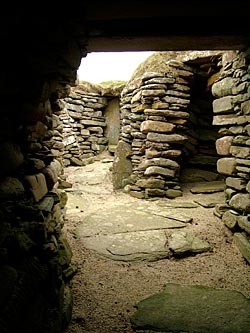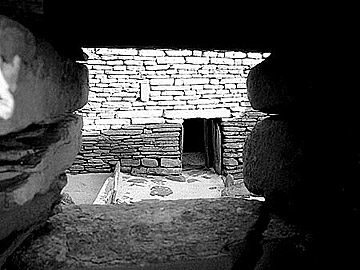
 |
 |
| Home |
| About Orkney |
| History |
| Tradition |
| Folklore |
| Placenames |
| Images |
| Downloads |
| About the Site |
| Contact |
| Links |
| Search Site |
| Awards |
| Skara Brae | |
|
Daily life in Skara Brae
The houses followed a standard plan, with the furniture laid out in a uniform manner — something which may have been symbolically important to the villagers. The architectural similarity between their houses — the houses of the living — and the chambered cairns – the houses of the dead — perhaps linked past generations with the present. It has long been suggested that the standardised house design was a sign that no one person was more important than another. With no architectural evidence that any one structure was grander, or more elaborate, it was suggested that, as in a commune, all the villagers were equal. This idea was first proposed by the site excavator, V. Gordon Childe, but may actually reflect the excavator's own communist leanings. Childe's interpretation led to the idea that Skara Brae was not a settlement where one family, or individual, held power over the others. Any community leader, or leaders, would have "earned" their position, perhaps through experience, and this status would not necessarily pass on to any offspring.
In more recent times, the typical Orcadian croft, for example, followed a fairly standard design, right through to the 19th century. In this case, there’s no suggestion of an egalitarian society of crofters. Instead, we know the buildings followed a tried and tested design — a plan known to the builders for generations and one which, through experience, was reasonably easy to build. To my mind, Skara Brae's architecture could be something similar. A tried and tested design — albeit one incorporating layers of deeper symbolism. Moving away from the social theories, life in Skara Brae was probably quite comfortable by Neolithic standards. Although contact with other communities could have seen trading of certain commodities, clay or pottery, for example, the villagers were settled farmers and probably fairly self-sufficient. Bones found in the midden, surrounding the houses, shows that cattle and sheep formed the main part of the Skara Brae diet, with barley and wheat grown in the surrounding fields. Complementing the farming produce, fish and shellfish were harvested in great quantities — and perhaps kept fresh within custom-built tanks within the houses. Fish were shore caught — mostly cod and saithe — while the wide range of shellfish reflects those that formed a staple part of the Orcadian diet until the 20th century. Huge quantities of limpet shells were found, but these may not have been a staple part of the Skara Brae diet. Through the centuries, limpets were generally regarded as an “emergency” food in Orkney, used only when there was nothing else available. Instead, they were harvested for bait, something that probably explains the quantities found in Skara Brae. The tanks within the houses could have been used to soak the limpets, softening them up before being used. The island's red deer and boar were also hunted for their meat and skins. Seal meat was consumed and, on the occasions when they found a beached whale, its meat would have provided a welcome feast. In addition, they, like the generations of islanders that followed them, probably collected the eggs of seabirds as well as harvesting the birds themselves. As well as providing meat, the animals, hunted and farmed, provided the skin and bone that was the raw material for the tools and needed for everyday life – needles, shovels, pins, knives, picks and adzes. The flint, or chert, required for their cutting edges, was either “imported” or gathered from the shore.
Because they were windowless (the window we can see in House One is not original – the seaward wall was reconstructed in the 19th century ), the interior of a Skara Brae house would have been dark, and probably smoky. Aside from the fire, in the centre of each room, the only light came, presumably, from a smoke hole in the roof. Possibly hanging from the rafters were fish, curing in the fire’s smoke. For fuel, the villagers probably burned a combination of seaweed and dried animal dung – fuels that remained in use until the 19th century - possibly along with the poor quality peat available to the villagers. Whether they burned driftwood is open to debate. In more recent years, driftwood was generally regarded as too valuable to burn. |
|

 However, it could also be argued that there was more practical reason for the identical layout of the houses.
However, it could also be argued that there was more practical reason for the identical layout of the houses. Many of the bone tools found suggests that animal skin was the main material for clothing. No evidence was found for equipment or tools that could have been used in the manufacture of textiles.
Many of the bone tools found suggests that animal skin was the main material for clothing. No evidence was found for equipment or tools that could have been used in the manufacture of textiles.